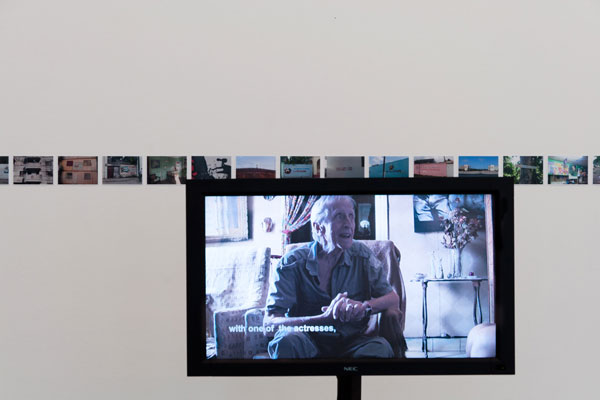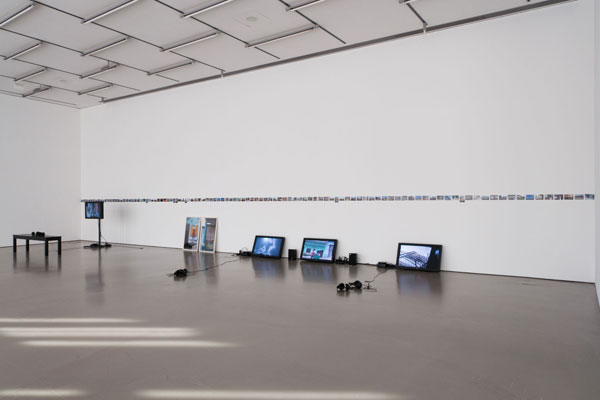Nostalgia, Installation, Mixmedia (video, photography), 2012














"If you want to go to Cuba, then do it fast, because socialism is ending there and what happened to Russia in the late 1980s is starting." This is the advice of a Russian tourist written on a website. And a travel guide recommends: "Nostalgic vacationers should travel to Cuba now, for it is unclear, at least since the severe illness of Fidel Castro, how long the stronghold of communism will survive." So now, in the early twenty-first century, communism has become a tourist attraction, with a visit to Cuba being a journey through time and politics a nostalgic memory of the times when history was still being made.
In 1964 a Soviet-Cuban film team, under the direction of Mikhail Kalatozov, shot a two-hour film about Cuba, "Soy Cuba", telling its revolutionary story through epic pictures. Conceived as a propaganda project by two nations connected by their establishment of socialism, which provided the producers with all necessary support for over two years, the film was greeted with no success whatsoever. Since the Cubans did not identify with the images or the story, the film stopped being shown a week later and was even banned in the Soviet Union.
Assembled in the film is basically a whole gamut of revolutionary elements, with the stunning landscape of the Caribbean island providing the backdrop: hedonistic Americans, women forced into prostitution, an impoverished rural population, the brutal police force, the persecution of insurgents, and the victorious revolution. Yet apparently no reality effect set in at the time, and it wasn't until much later that the film was rediscovered as a cinematic masterpiece - when the revolution was nothing more than a memory and still present only in the film itself, or today as graffities along walls and on house exteriors: "We will always remain loyal champions of socialism"; "The victory was, is, and will always be ours"; "Long live Fidel and Raul"; and even "Socialism or Death". In the summer of 2012 Anna Jermolaewa visited some sites shown in the film, for instance the legendary "Hotel Capri" and the cinema "Teatro Cuba", where the film premiere was celebrated; she speaks with members of the crew who worked on the film, such as Enrique Pineda Barnet, who helped to write the screenplay. The journey aims to trace the filming process and the relationship to the contemporary Cuba of the 1960s as conveyed within the film, and thus also the position of artistic reality vis-à-vis the reality of politics and history before the last vestiges are removed and vanish into nostalgia.
Reinhard Braun
***
»Wenn Sie nach Kuba wollen, machen Sie das schnell, der Sozialismus geht dort zu Ende und es beginnt das, was in Russland Ende der 80er geschah«, schreibt ein russischer Tourist auf einer Internet-Seite. Und in einem Reiseführer heißt es: »Nostalgisch gestimmte Urlauber sollten jetzt nach Kuba reisen. Denn spätestens seit der schweren Erkrankung von Staatschef Fidel Castro ist unklar, wie lange sich die kommunistische Bastion noch halten kann«. Der Kommunismus ist somit Anfang des 21. Jahrhunderts zu einer Touristenattraktion geworden, der Besuch Kubas zu einer Art Zeitreise, Politik zu einer nostalgischen Erinnerung an jene Zeiten, in denen Geschichte noch stattfand.
1964 drehte ein sowjetisch-kubanisches Filmteam unter der Regie von Mikhail Kalatozov einen mehr als zweistündigen Film über Kuba, »Soy Kuba«, der dessen revolutionäre Geschichte in epischen Bildern erzählt. Als Propaganda-Projekt zweier im Aufbau des Sozialismus verbundenen Nationen, dem alle notwendigen Mittel über mehr als zwei Jahre zur Verfügung gestellt wurden, hatte der Film jedoch keinerlei Erfolg – die KubanerInnen fanden sich in den Bildern und der Geschichte nicht wieder, nach einer Woche wurde der Film vom Spielplan genommen, in der Sowjetunion sogar verboten.
Die vergnügungssüchtigen Amerikaner, die zur Prostitution genötigten Frauen, die verarmte Landbevölkerung, die studentischen Revolutionäre, die brutale Polizei, die Verfolgung der Aufständischen, der Sieg der Revolution: im Grunde sind alle Elemente des Revolutionären versammelt, die Folie dafür liefert die überwältigende Landschaft der karibischen Insel. Dennoch stellte sich offenbar kein Realitätseffekt ein, erst viel später wurde der Film als cineastisches Meisterwerk wiederentdeckt, als die Revolution nur mehr eine Erinnerung war und allein im Film selbst gegenwärtig oder heute als Graffitis an den Mauern und Hauswänden: »Stets werden wir treue Verteidiger des Sozialismus sein«; »Der Sieg war, ist und wird immer unser sein«; »Es leben Fidel und Raul«, und sogar »Sozialismus oder Tod«.
Anna Jermolaewa besuchte im Sommer 2012 die Schauplätze dieses Films, so etwa das Dach des legendären »Hotel Capri« und das Kino «Teatro Cuba«, in dem die Premiere des Films stattfand, sie sprach mit MitarbeiterInnen am Film, etwa mit Enrique Pineda Barnet, der am Skript mitgeschrieben hat. Die Reise versucht, die Dreharbeiten und das Verhältnis, in dem der Film zur Gegenwart Kubas in den 1960er Jahren stand nachzuvollziehen und damit das Verhältnis, in welchem die künstlerische Wirklichkeit zur Wirklichkeit von Politik und Geschichte stand, bevor die letzten Spuren beseitigt sein werden und sie völlig der Nostalgie anheimfallen.
Reinhard Braun